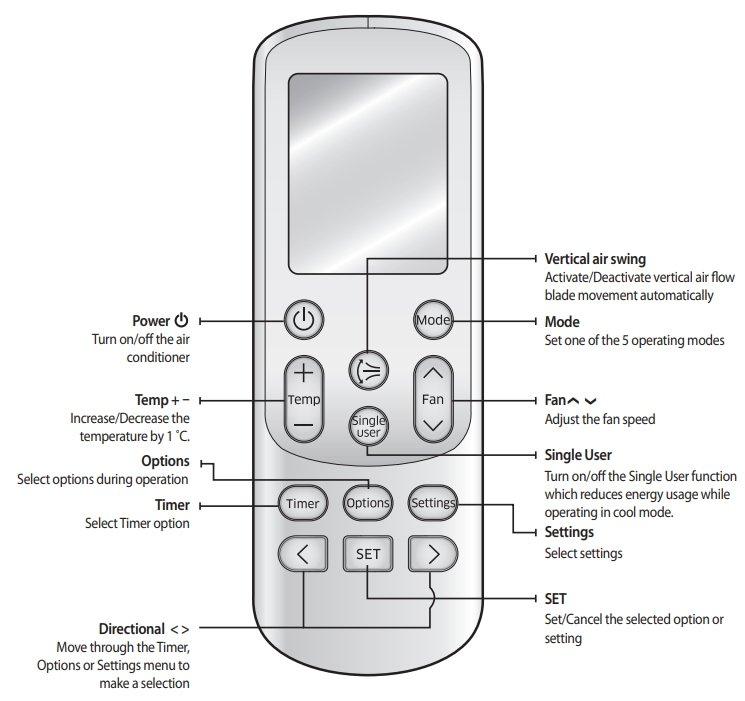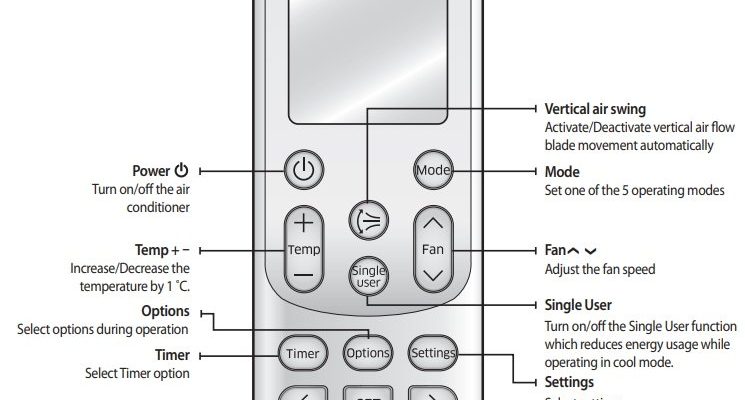
Think of your AC remote as a flashlight. You shine the beam (in this case, an invisible infrared signal) towards the AC, and if you’re too far away—or not pointing in just the right spot—it’s like waving your hands and hoping the ceiling fan will listen. So, how far is too far? And why does it even matter for everyday use? Let’s break down what you really need to know about the range, how it works, and what to do when your trusty Samsung AC remote just doesn’t seem to be reaching anymore.
What’s The Typical Range Of A Samsung AC Remote?
Here’s the thing—most people don’t actually think about their remote’s range until it stops working from their favorite spot on the bed or across the living room. For most Samsung air conditioner remotes, the typical range is around 16 to 20 feet (about 5 to 6 meters). That’s roughly the distance from your TV console to the back wall of a medium-sized room, or just long enough to reach most corners of a bedroom without playing fetch.
But it’s not just about distance. The remote needs a clear line of sight to the AC’s receiver, which is usually a small, dark window or eye on your indoor unit. If you’re dealing with a lot of furniture, curtains, or oddly placed plants, that signal can get blocked. Think of it like throwing a paper airplane—the farther you’re standing, and the more stuff in the way, the less likely it’ll hit the target. Fun fact: the signal from your Samsung AC remote uses infrared (IR), not Wi-Fi or Bluetooth. That means walls and obstacles block it entirely.
So, if you find yourself standing up or waving the remote around like you’re at a concert, it’s not just you—the range really does have its limits. And depending on the age of your unit or the batteries inside, that range can get even shorter.
How Does The Technology Behind The Remote Work?
Let me explain how these magical little devices do their job. Your Samsung AC remote works by sending out a special signal—specifically, an infrared light beam (IR)—which carries a code for whatever command you’ve pressed (temperature up, fan speed, power on, etc.). The AC’s receiver sees that flash of invisible light, translates the code, and does what you told it to.
What’s wild is that, even though the light is invisible to us, it’s just as real as what comes out of a TV remote control. IR signals are super cheap, reliable, and simple, but they do have rules: they can’t go through walls, and they don’t bounce around corners very well. Think of it like a tiny game of “laser tag”—if you can’t see the target, it’s probably not going to work.
Here’s something else: newer AC models and smart remotes sometimes include different tech, like Wi-Fi or Bluetooth, which can pass through obstacles. But the classic, included remote in most Samsung split ACs and window units sticks with the trusty infrared beam. This means range isn’t just about the numbers; it’s about where you’re pointing and what’s between you and the unit.
Common Problems That Affect Remote Range
Honestly, there’s nothing more annoying than pressing those remote buttons and getting zero response. So, what actually limits the range on your Samsung AC remote? More than you might think.
- Low battery power: If your remote’s batteries are running low, the IR signal gets weak. Even brand-new remotes will give up early if the battery is fading. Always try fresh batteries first if you notice the range seems to shrink.
- Obstacles and line of sight: Furniture, walls, curtains, or even decorative items can interrupt the signal beam. I once moved a laundry basket and suddenly my remote started working again—no joke.
- Dirty or blocked IR sensors: Dust or grime on either the remote’s IR bulb or the AC receiver’s window can mess things up. It’s like trying to shine a flashlight through a dirty glass—clean those spots gently with a cloth if things get glitchy.
- Angle of operation: If you’re pointing the remote too far off-center, the beam can miss the receiver. Samsung recommends aiming directly within a 30–45 degree arc of the sensor for best results.
Each of these can chop that 16-20 foot range down to almost nothing. Sometimes, a quick troubleshoot—like wiping the sensor, swapping the batteries, or clearing the line of sight—makes your remote feel brand new again.
Why Does Range Matter For Everyday Use?
You might be wondering, “Do I really need to use my remote from across the room?” Maybe not every day, but here’s why it can matter more than you think. Imagine you’re hosting friends for movie night, and the room suddenly becomes a sauna. Nobody wants to pause the fun just to walk up and press buttons on the unit. Or picture trying to adjust the AC settings in the middle of the night—less range means actually getting out of bed (and who wants that?).
For folks with bigger rooms or open-concept living spaces, the standard IR remote might fall short. You might find yourself playing a game of “find the closest spot” where your remote actually works. It’s a tiny inconvenience, but in the age of smart devices and instant everything, even little hiccups like this can be frustrating.
And don’t forget about accessibility. Not everyone can easily walk over to the AC or reach around furniture. Good remote range means more convenience—and sometimes, a lot more comfort.
Tips For Maximizing The Range Of Your Samsung AC Remote
Let’s get practical. If you feel like your remote’s range is shrinking, or it just never seems to reach as far as you want, there are a few things you can do.
- Change the batteries often—even before they’re totally dead. Weak batteries make a weak signal.
- Clear any obstacles between you and the AC. If possible, move large furniture or at least make sure you have a clean line of sight from your favorite spot.
- Keep the sensors clean. Both on the remote and the AC itself. Use a soft, dry cloth—no liquids.
- Point the remote directly at the receiver. It’s tempting to wave the remote around, but these guys work best if you aim right at the target.
- Stay inside the 20-foot range. If you need more, it might be time to consider a different solution (like a universal or smart remote).
Sometimes, troubleshooting is just a process of elimination. If none of this helps, your remote might have a deeper issue (like a faulty IR LED or a problem with the AC receiver). At that point, checking the code, attempting to reset or sync your remote, or even pairing a new one can be the answer.
Universal Remotes And Smart Alternatives: Do They Have Better Range?
Here’s where things get interesting. If you’re not satisfied with the standard range, you might be tempted to try a universal remote or a smart home solution. Are they any better? Well, sometimes yes—and sometimes no.
Universal remotes often work on the same infrared technology, so their range is similar (and limited by the AC’s own IR receiver). But some “smart” remotes or Wi-Fi hubs—a bit fancier, I admit—allow you to control the AC from anywhere in your home using your phone or a voice assistant. That’s because instead of sending a direct beam, they rely on Wi-Fi or Bluetooth, which can travel through walls and around corners.
Of course, there’s a catch: these systems need setup, extra devices, and sometimes monthly fees. Not everyone wants to mess with Wi-Fi codes or app permissions just to turn on the AC. But if you love gadgets, or your room layout makes standard remotes tricky, it’s a game-changer.
If all you want is a simple way to control your Samsung AC from across the room, the included remote should work as long as you stay within that 16–20 foot range and keep the path clear. But for ultimate flexibility, smart home upgrades are worth thinking about.
How To Troubleshoot Short or Dead Remote Range
Ugh, so you’ve tried everything—fresh batteries, careful aiming, a spotless receiver—yet your Samsung AC remote still barely works beyond arm’s length. Don’t worry, it happens more often than you’d think. Here’s what to do, step by step.
First, double-check your batteries. Even brand-new batteries can be duds. If you have a battery tester or spare pack, try swapping them out again. Next, check the IR bulb on your remote. If it looks cloudy, scratched, or loose, it might not be sending out a strong signal.
Still nothing? Try using the remote in a dimly lit room and point it at a digital camera (yep—your smartphone will work). When you press a button, you should see a faint white or purple flash on the camera screen. If you don’t, the remote isn’t sending out IR, and you’ll probably need a replacement or repair.
If the remote flashes but your AC still ignores it, the issue might be with the receiver on the AC unit itself. Make sure nothing’s covering it, and try resetting your AC (consult the manual for your model’s reset or pair instructions). If all else fails, you can try a universal remote or call in a technician to troubleshoot further.
Why You Might Want To Upgrade Or Replace Your Remote
Sometimes, no matter how much troubleshooting you do, the remote is just… done. Maybe it got dropped one too many times, or the IR emitter finally wore out. If that’s the case, don’t stress—you’ve got options.
You can buy a new Samsung-branded remote online, which will give you the same range and features as the original. If you’ve misplaced the original code, most universals now come with a lookup table, so you can sync or pair them easily for most Samsung AC models. Just be sure the replacement remote matches your AC’s model number. Honestly, going universal is fine if you want a backup, but a genuine Samsung remote is usually the best bet for full functionality and range.
If you’re feeling a bit techy, there are also smart IR blasters that connect to your Wi-Fi. With these, you can control your AC via an app, schedule on/off times, or even sync with Google Home or Alexa for voice control. It sounds a bit sci-fi, but in apartments or bedrooms where you want trouble-free comfort, it’s actually pretty awesome.
Wrapping Up: Making The Most Of Your Samsung AC Remote’s Range
At the end of the day, the range of your Samsung AC remote comes down to a few simple things: a clear path, strong batteries, and a good aim. Most people won’t run into problems if they stay inside that 16–20 foot window, but little issues—like low batteries or blocked sensors—are surprisingly common.
If you’re struggling with range, start with the basics: swap in new batteries, move any big obstacles, and give those sensors a gentle wipe. Try syncing or resetting your remote if it’s still fussy. And if you want more flexibility, consider looking into universal or smart remotes for a true upgrade.
Honestly, nobody enjoys running across the room just to change the AC setting, especially during a heatwave. So, with just a little troubleshooting and some clever tweaks, you can keep things cool (or warm) right from your favorite seat. Stay comfy—your perfect room temperature is only a click (and a few feet) away.
